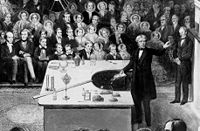 I mentioned a while ago that I was thinking of rewriting the Wikipedia page on the History of Physics from scratch. And I did. (Archived copy here, in case you’re reading this post from this blog’s archives). Now, there are a lot of complaints to be made about Wikipedia articles. In the history of science, they can be almost painfully Whiggish. In this case, I felt justified because the prior version of the History of Physics article was not only methodologically suspect, but, really, more or less unreadable, and it was clear that piecemeal amendment would not be a useful path and that no one else was going to undertake the project.
I mentioned a while ago that I was thinking of rewriting the Wikipedia page on the History of Physics from scratch. And I did. (Archived copy here, in case you’re reading this post from this blog’s archives). Now, there are a lot of complaints to be made about Wikipedia articles. In the history of science, they can be almost painfully Whiggish. In this case, I felt justified because the prior version of the History of Physics article was not only methodologically suspect, but, really, more or less unreadable, and it was clear that piecemeal amendment would not be a useful path and that no one else was going to undertake the project.
So, if an academically-trained historian is going to just swoop in and do this kind of thing, what ought to be taken into account? I feel Wikipedia is an opportunity not only to correct inadequate views, but to create a resource that can serve as both a primer on a topic, as well as a guide to various levels of literature (popular, scholarly overview, detailed scholarly work, etc…). This can be done, I think, with judicious use of documentation.
I don’t think my take on the history of physics required many references by academic standards, but the Wikipedians can be persnickety about this kind of thing. The Master of Physics Articles on Wikipedia, known as “Headbomb”, reverted my edit earlier this month, because I hadn’t yet put in new documentation and pictures. That’s fixed. I now have used the “Further Reading” section to suggest some general overviews for interested readers, while the “References” section basically serves as a “books about this
Read More…Read More…